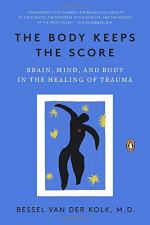
|
| Name: _________________________ | Period: ___________________ |
This test consists of 5 multiple choice questions, 5 short answer questions, and 10 short essay questions.
Multiple Choice Questions
1. In what year was the diagnosis of PTSD added to the American Psychiatric Association's array of diagnoses?
(a) 2000.
(b) 1980.
(c) 1970.
(d) 1990.
2. In what year did Van der Kolk meet Tom?
(a) 1998.
(b) 1978.
(c) 1988.
(d) 2008.
3. Van der Kolk states that when people are faced with danger, they secrete what substance?
(a) Pheromones.
(b) Sweat.
(c) Dopamine.
(d) Stress hormones.
4. Van der Kolk asserts that SSRIs such as Prozac should act as what element in the comprehensive treatment plan of a survivor of trauma?
(a) The main treatment.
(b) At least half of their treatment.
(c) An adjunct in their overall treatment.
(d) Only part of their treatment during emergencies.
5. Which level of the autonomic nervous system's response to danger is characterized by actions like entering a fugue state?
(a) Fight or flight.
(b) Neuroception.
(c) Social engagement.
(d) Freeze or collapse.
Short Answer Questions
1. Van der Kolk states that he grew up in which country during the postwar years?
2. From what location did Noam watch a plane slam into the World Trade Center on the morning of 9/11?
3. What are the only people in Noam's drawing doing within his picture of the scene of 9/11?
4. On which symptom of Tom's did Van der Kolk focus his initial treatment?
5. In which part of the brain did PTSD sufferers show no activity when shown images of people looking at them with direct gazes?
Short Essay Questions
1. What conclusion did Van der Kolk reach about the treatment of trauma after reading Charles Darwin's book The Expression of the Emotions in Man and Animals?
2. What aspect of the assessment Van der Kolk gave to Noam intrigued Van der Kolk the most and why?
3. What relationship does Van der Kolk identify between trauma and sensory experiences?
4. What traumatic event did Noam, the five-year-old discussed in Chapter 4, "Running For Your Life" witness?
5. Discuss Bessel Van der Kolk's use of a metaphor within the dedication of The Body Keeps the Score: Brain, Mind, and Body in the Healing of Trauma.
6. What aspects of Noam's traumatic experience made it unlikely that he would suffer lasting negative effects throughout his life?
7. What is Van der Kolk's purpose for including a story about Tom's refusal to take his prescribed medication?
8. What does the cage symbolize within Van der Kolk's story about Steven Meier's experiments?
9. What problems began to manifest in Tom's life despite his appearance of an easy transition back to his normal life upon returning from combat?
10. What type of assessment did Van der Kolk provide to Noam to figure out whether he was likely to experience lasting trauma?
|
This section contains 1,328 words (approx. 5 pages at 300 words per page) |

|




